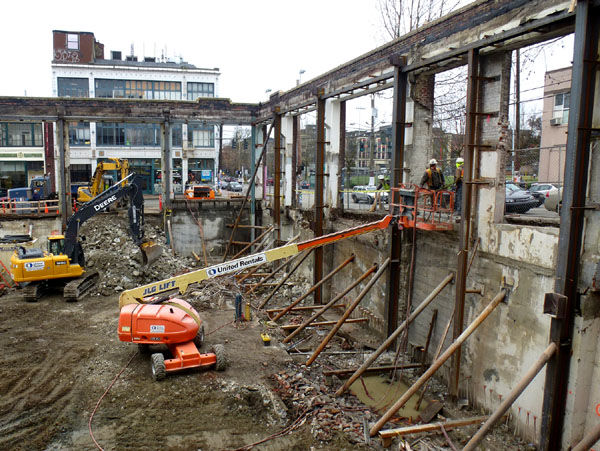\ \ \ TANKSHOTS (6) \ \ \
Someone’s sure going though a lot of trouble to save the lanky brick facade of the 1926 Sunset Electric building at 11th and Pine in Capitol Hill. It’s hard to imagine how the extra floor the developer is allowed to add to the new building in exchange could possibly offset the additional cost of building around all that fragile brickwork.
Either way, this project is a good example of how we tax density to fund public benefits—in this case, preservation of the Pike/Pine neighborhood’s historic character.* On the one hand, City policy dictates that adding density to urban centers like Capitol Hill is a strategy for achieving broad sustainability goals—and that is entirely correct. But on the other, the City tells developers that if they want to put more than a given level density on a site, then they’ll have to pay a toll to fund public benefits.
Apologists for this contradiction point out that if the developer did not save that facade, the reduced construction cost would not translate to lower rents, but would be pocketed as developer profit. Perhaps true, but if developers make a big profit it’s only because they have figured out how to efficiently deliver a product that a lot of people want. In any other field, that success would be admired as ingenuity and smart business.
Furthermore, the reason owners can charge prices that exceed the cost of production is because housing supply is not meeting demand, and building more supply is the only way to relieve that pressure on prices and bring the system back in balance. If there’s a potential for a healthy profit, the free market will do its thing, and eventually the so-called “problem” of developers making too much profit will correct itself as prices come in line with the cost of production. This outcome is a win-win for housing affordability and for the numerous sustainability benefits of density. In contrast, encumbering the production of housing supply—whether through density fees or other regulations, delays, or political wrangling—is a recipe for the lose-lose outcome of higher prices and less density.
As for public benefits, we need to find a way of funding them that doesn’t have the unintended consequence of penalizing new housing development, which is in effect punishing newcomers to the City to the benefit of those who are already here. A more fair approach would be to spread the burden equitably across the entire City, to both new and old properties. Indeed, the most fair approach would place a larger share of the burden on those living in low-density housing (a.k.a. single-family) that does not provide the public benefits of density.
>>>
*One could argue that this kind of “facadomy” doesn’t contribute much in the way of meaningful preservation, but that’s another debate.
>>>
Photo by the author. This post is part of a series.


